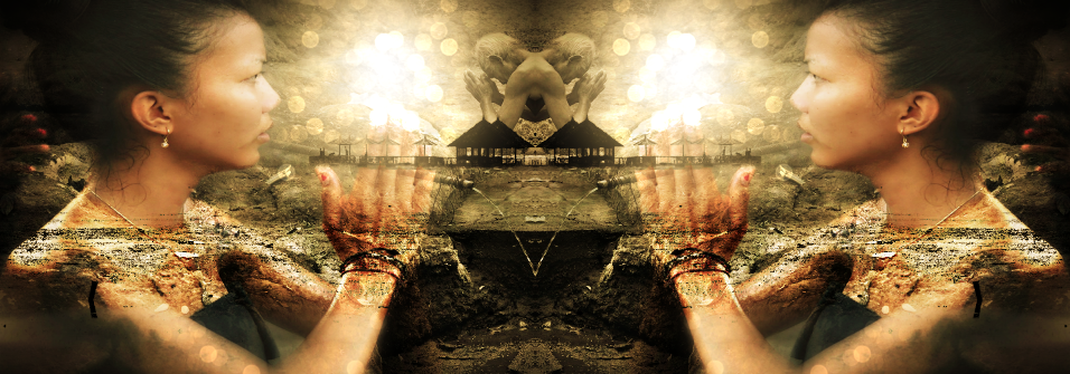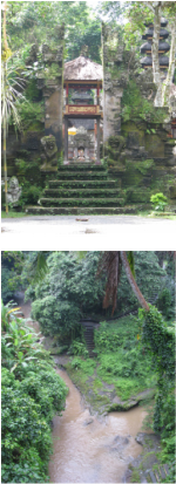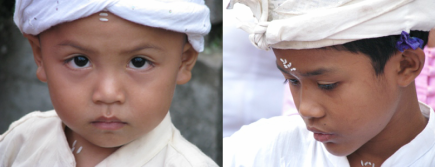Ubud Legend
|
In the eighth century, a Javanese Buddhist Priest, Rsi Marhandya saw a distant light rising from the earth to the sky and returning again. So Rsi organized a large group of men and women to find the place which was the source of the light. On this first journey he found a beautiful island as we know now as Bali. By the time Rsi and the search party eventually reached the mountains they came across Taro (30 minutes from Ubud) where he and his men fell ill and many died, they returned to Java where Rsi had another vision, regrouped his men and set out on his quest again. After a long journey he finally found the place of the light in the central mountains of Bali, Ubud, and this time built a sacred temple on the site.
On the journey, Rsi was led to stop and meditate at a place where two rivers met. It was at Campuhan (which actually means two rivers meet) that Rsi Marhandya received the inspiration he needed on how to build what is now one of the most revered and beautiful temples in all the world. He meditated at the confluence of the two Wos Rivers at Campuhan, just west of the modern day town centre. To mark this place of holy inspiration, a small temple was built on the banks of Campuhan and the surrounding land granted to the royal family of the town near Campuhan and refers to the healing power of this most sacred ground. Ubud means Medicine in Balinese, Ubud was originally called Ubad and was revered as a source of medicinal herbs and plants. Tjokorda Raka of the Ubud Royal family has had a dream of opening up this and sharing the rejuvenating life of this place with visitors of other cultures. A shrine was established and later expanded by Nirartha, the Javanese priest who is regarded as the founder of Bali's religious practices and rituals as we know them today. Campuhan has continued to be a source of light and inspiration for many, attracting artists and musicians of worldwide notoriety such as Walter Spies, Rudolf Bonnet, Colin Macphee, and Noel Coward, last but not least in this line was Antonio Blanco. |
|
More Links to Information on Ubud
|
Temples
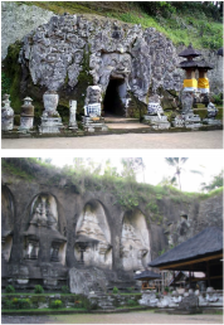
Further temples and monasteries were established over the next 400 hundred years or so, the ninth century cave temples at Goa Gajah, the famed Elephant Cave (just east and northeast of Ubud), are architectural remains from this period and many of the dances, drama and rituals still practiced in Ubud today, originated at this time. King Airlangga ruled all of Java and Bali in this era, and his seat of government was located in what is now the village of Batuan, just southeast of Ubud.
Another beautiful temple built around this time was Gunung Kawi, an 11th century temple complex in Tampaksiring north east of Ubud in Bali, Indonesia. It is located on the river Pakrisan. The complex comprises 10 rock-cut candi (shrines) carved into the cliff face. They stand in 7m-high (23 ft-high) sheltered niches cut into the sheer cliff face. These monuments are thought to be dedicated to King Anak Wungsu of the Udayana dynasty and his favourite queens.
The Javanese Majapahit kingdom conquered Bali in 1343, and the key final victory was against the Pejeng Dynasty centred at Bedulu, just to the east of Ubud. A great flowering of Balinese culture followed, and the ancestry of Ubud's current day aristocratic families can be traced back to this period. In the sixteenth Century, there was a total transplantation of the Majapahit Kingdom to Bali as the Islamisation of Java forced them eastwards. Power flip-flopped between various dynasties and feudal lords, but the Ubud area remained a very important cog in the various regencies which ruled the island.
It has been the stamping ground of Bali's earliest dynasties in recorded history. It is here that the first great lines of Hindu Zed Kings established themselves. Pejeng was the center of power until the early 14th century, when the last line of Warmadewa was defeated by Majapahit Empire, Under Gajah Mada, in 1343. The two rivers, Petanu and Pakrisan, have been storing series of ancient historical remains along the banks, such as temples, meditation cells, baths and other monuments.
Another beautiful temple built around this time was Gunung Kawi, an 11th century temple complex in Tampaksiring north east of Ubud in Bali, Indonesia. It is located on the river Pakrisan. The complex comprises 10 rock-cut candi (shrines) carved into the cliff face. They stand in 7m-high (23 ft-high) sheltered niches cut into the sheer cliff face. These monuments are thought to be dedicated to King Anak Wungsu of the Udayana dynasty and his favourite queens.
The Javanese Majapahit kingdom conquered Bali in 1343, and the key final victory was against the Pejeng Dynasty centred at Bedulu, just to the east of Ubud. A great flowering of Balinese culture followed, and the ancestry of Ubud's current day aristocratic families can be traced back to this period. In the sixteenth Century, there was a total transplantation of the Majapahit Kingdom to Bali as the Islamisation of Java forced them eastwards. Power flip-flopped between various dynasties and feudal lords, but the Ubud area remained a very important cog in the various regencies which ruled the island.
It has been the stamping ground of Bali's earliest dynasties in recorded history. It is here that the first great lines of Hindu Zed Kings established themselves. Pejeng was the center of power until the early 14th century, when the last line of Warmadewa was defeated by Majapahit Empire, Under Gajah Mada, in 1343. The two rivers, Petanu and Pakrisan, have been storing series of ancient historical remains along the banks, such as temples, meditation cells, baths and other monuments.
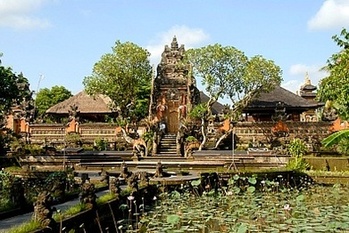
Sacred Temples
Pura Desa Ubud: The main "town temple" in the centre, across from Ary's Warung.
Pura Puseh: The "temple of origin" devoted to Ubud's honoured ancestors. In Jalan Suweta.
Pura Dalem Ubud: The temple for the dark side of things. On the north side of Jalan Raya before the road descends to Campuan.
Pura Pamerajan Sari C. Agung: The private family temple of the Ubud royal family. On the east side of Jalan Suweta, a little north of the Palace.
Pura Taman Saraswati: Part of the Puri Saraswati complex, devoted to Dewi Saraswati the goddess of learning, literature and the arts, Features a fine padmasana (lotus throne). Beyond the lotus pond in the back of Cafe Lotus.
Pura Dalem Agung Padangtegal: Another temple for the dark side, down by the monkey forest.
Pura Gunung Lebah: At the confluence of the east and west branches of the Wos River , below the Campuan bridge.
Pura Batur Sari: A royal temple devoted to the deity of Mt Batur, ostensibly to spare the Ubud Tjokordas the long journey up to the mountain itself. During its odalan, the dance stage is set up in front of the temple, right in the middle of Jalan Suweta, a few hundred metres north of Ubud's main cross-roads.
Pura Desa Ubud: The main "town temple" in the centre, across from Ary's Warung.
Pura Puseh: The "temple of origin" devoted to Ubud's honoured ancestors. In Jalan Suweta.
Pura Dalem Ubud: The temple for the dark side of things. On the north side of Jalan Raya before the road descends to Campuan.
Pura Pamerajan Sari C. Agung: The private family temple of the Ubud royal family. On the east side of Jalan Suweta, a little north of the Palace.
Pura Taman Saraswati: Part of the Puri Saraswati complex, devoted to Dewi Saraswati the goddess of learning, literature and the arts, Features a fine padmasana (lotus throne). Beyond the lotus pond in the back of Cafe Lotus.
Pura Dalem Agung Padangtegal: Another temple for the dark side, down by the monkey forest.
Pura Gunung Lebah: At the confluence of the east and west branches of the Wos River , below the Campuan bridge.
Pura Batur Sari: A royal temple devoted to the deity of Mt Batur, ostensibly to spare the Ubud Tjokordas the long journey up to the mountain itself. During its odalan, the dance stage is set up in front of the temple, right in the middle of Jalan Suweta, a few hundred metres north of Ubud's main cross-roads.
